Getting Around – Transport In The UK
 Getting Around – Transport In The UK
Getting Around – Transport In The UK
The world’s oldest underground rail system, the Tube’s first Circle and Hammersmith and City lines opened in 1863, with 11 lines now in operation across 270 stations. The system is divided into six zones, with set fares dependent on the number of zones transversed in a single journey. Ticket machines or staffed ticket offices are at all stations and the system runs daily between 05:30 and 01:00.
The national rail network covering the UK can be confusing for incomers as it includes a number of rail companies, the largest of which is Network Rail. Commuter services run into London and large cities and intercity trains are fast and regular. The fare structure is even more confusing, with various prices for journeys dependent on the time of travel, the route and the rail company itself.
Travelling by overland rail is expensive, especially for commuters into the centre of London, with annual fare increases of up to 10 per cent the order of the day and trains packed out during rush hours. Commuting into London and large cities by car can also be frustrating, with long delays due to volume of traffic, with all-day parking strongly discouraged in the city centre by means of price. Some city districts forbid on-street parking altogether.
London and other UK cities have extensive bus networks, although extended journey times are usual in rush hours, again due to the high volume of road traffic heading to city centres. Long distance bus travel between cities is inexpensive and comfortable, with routes across the country spreading out from London’s Victoria Coach Station and cross-country routes connecting cites in all UK regions.
Rail and bus transport in Scotland, Wales and Northern Ireland is generally modern and well-organised, although remoter destinations may only be accessible by bus or car. Glasgow has the only rapid transport underground system in Scotland and ferries play an essential part of goods and personal transportation to the Scottish Islands and from the UK mainland to Northern Ireland.


